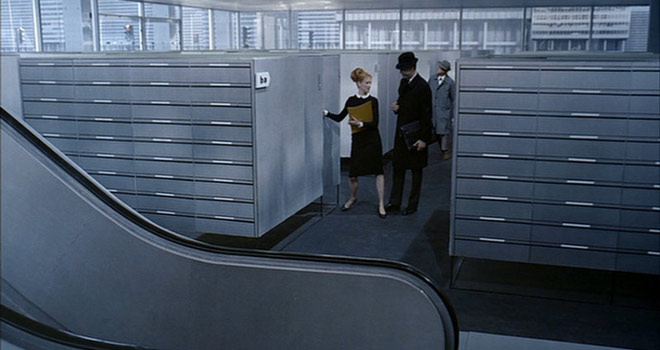
In some societies, sexual activity is prohibited during certain times of day. The Cuna of Panama approve of sexual relations only at night in accordance with the laws of God. The Semang of Malaysia believe that sex during the day will cause thunderstorms and deadly lightening, leading to drowning of not only the offending couple but also of other innocent people. And the West African Bambara believe that a couple who engage in sex during the day will have an albino child.
Sometimes, sex is prohibited in certain places. The Mende of West Africa forbid sexual intercourse in the bush, while the Semang condemn sex with camp boundaries for fear that the supernatural will become angry. Among the Bambara, engaging in sexual relations out of doors will lead to the failure of crops.
{ Encyclopedia of Sex and Gender/Mind Hacks | Continue reading }
sex-oriented |
November 19th, 2012

The OECD has a new report out projecting what countries’ economic output, both total and per capita, will be in 2060. Unsurprisingly, the Chinese and Indian economies will have eclipsed the U.S. one, which will remain in third place.
But the per capita numbers are more striking, and encouraging. The report projects that between 2011 and 2060, real GDP per capita will increase sevenfold in India and China. In China, that means a jump from $8,387 in 2011 to almost $60,000 in 2060, in constant 2011 dollars. By contrast, U.S. GDP per capita in 2011 was $48,328.
OECD also projects declining inequality between countries over the next fifty years. The United States will still have a much bigger GDP per capita than China in 2060 — about $136,611, if the OECD is right. But that’s a little more than double China’s level, whereas today, U.S. GDP per capita is almost six times that of China’s.
{ Washington Post | Continue reading }
photo { Mark Power , The Shipping Forecast, 1992-96 }
asia, economics, photogs, within the world |
November 19th, 2012

{ Why is the polyp Hydra immortal? Researchers from Kiel University decided to study it — and unexpectedly discovered a link to aging in humans. | Kurzweil | full story }
mystery and paranormal, science |
November 19th, 2012
ideas, photogs, technology |
November 18th, 2012

It’s all about the fact that people want to achieve two things at the same time. We want to think of ourselves as honest, wonderful people, and then we want to benefit from cheating. Our ability to rationalize our own actions can actually help us be more dishonest while thinking of ourselves as honest. So the idea that everybody else does it, or the idea that nobody is really going to suffer, or the idea that the entity you are stealing from is actually a bad entity, or the idea that you don’t see it—all of those things help people be dishonest.
{ Daniel Ariely/The Politic | Continue reading }
economics, psychology, scams and heists |
November 18th, 2012

The three most disruptive transitions in history were the introduction of humans, farming, and industry. If another transition lies ahead, a good guess for its source is artificial intelligence in the form of whole brain emulations, or “ems,” sometime in roughly a century.
{ Overcoming Bias | Continue reading }
A case can be made that the hypothesis that we are living in a computer simulation should be given a significant probability. The basic idea behind this so-called “Simulation argument” is that vast amounts of computing power may become available in the future, and that it could be used, among other things, to run large numbers of fine-grained simulations of past human civilizations. Under some not-too-implausible assumptions, the result can be that almost all minds like ours are simulated minds, and that we should therefore assign a significant probability to being such computer-emulated minds rather than the (subjectively indistinguishable) minds of originally evolved creatures. And if we are, we suffer the risk that the simulation may be shut down at any time.
{ Nick Bostrom | Continue reading | Related: Nick Bostrom, Are you living in a computer simulation?, 2003 }
photo { Matthew Pillsbury }
future, ideas, photogs, technology |
November 17th, 2012

Rousseau at fifty-three — afflicted by illness, temperamental and alone, an anguished, paranoiac conscience — sitting up at his desk in Wootton, in the 1760s: “Nothing about me must remain hidden or obscure. I must remain incessantly beneath the reader’s gaze, so that he may follow me in all the extravagances of my heart and into every last corner of my life.”
The Confessions are Rousseau’s response, in the form of a remedy, to the pain and contradictions of a human heart filled with content that can no longer be transmitted vertically, toward the heavens. The task of the accused to supply proof of innocence, to authenticate the rightness of his conduct, requires a new, lateral kind of divination. A community of readers, not saints, is what counts.
{ Ricky D’Ambrose/TNI | Continue reading }
photo { Brittany Markert }
ideas, photogs |
November 16th, 2012

Food and nutrition. In concept it seems straightforward enough. Food is what we eat to obtain the nourishment and thus the energy to keep us going from day to day. Yet food has undergone radical changes over the past hundred years, especially in the industrialized West. People who lived at the turn of the 20th century wouldn’t recognize today’s grocery stores, and they certainly wouldn’t recognize much of what fills grocery store shelves as nourishment.
It all began with a push toward greater convenience in an increasingly mechanized world. Electricity and then electronics brought with them an endless stream of new gadgets for the home, each promising to make life easier in some way. Many of these time- and labor-saving devices were destined for the kitchen. Factories, too, were retooled to streamline the manufacture of everything, including food. But a growing segment of today’s population is concerned about healthy eating and about the place of heavily processed foods in their diet. Should convenience be the ruler by which we measure food and nutrition?
Some convenience foods actually predate the 20th century, among them canned soups, fruits and vegetables; gelatin dessert mixes; ketchup and other prepared condiments; pancake mixes; ready-to-eat breakfast cereals; sweetened condensed milk. After the First World War, these and more found their way into the kitchens of eager young housewives, with manufacturers often promoting their innovative products via free recipe books.
There’s no denying that flavor, texture and nutrients suffered, but people began to rely on these conveniences, and their tastes simply changed to accommodate. […]
Throughout the 20th century, the food industry worked to provide not only convenience but also ostensibly wholesome substitutes for natural foods, including butter. In fact, margarine has been around since the late 19th century, but for many years it was white by law. Eventually, however, it came with added artificial flavor and a capsule of yellow artificial food coloring (to be kneaded in after purchase) so it would taste and look more like the real thing. […]
After several generations of variations on this theme, however, we are seeing the effects of eating foods that are so far removed from their original state. Not only are many diseases linked to poor diet—from certain cancers to diabetes to heart disease—but obesity affects an unprecedented segment of the Western population.
{ Vision | Continue reading }
economics, food, drinks, restaurants, gross |
November 16th, 2012

This article looks in more depth at the different ways in which ideas about cashless societies were articulated and explored in pre-1900 utopian literature. Taking examples from the works of key writers such as Thomas More, Robert Owen, William Morris and Edward Bellamy, it discusses the different ways in which the problems associated with conventional notes-and-coins monetary systems were tackled as well as looking at the proposals for alternative payment systems to take their place. Ultimately, what it shows is that although the desire to dispense with cash and find a more efficient and less-exploitable payment system is certainly nothing new, the practical problems associated with actually implementing such a system remain hugely challenging.
{ MPRA/Academia | Continue reading }
economics, ideas |
November 16th, 2012

Inattentional blindness-the failure to see visible and otherwise salient events when one is paying attention to something else-has been proposed as an explanation for various real-world events. In one such event, a Boston police officer chasing a suspect ran past a brutal assault and was prosecuted for perjury when he claimed not to have seen it. However, there have been no experimental studies of inattentional blindness in real-world conditions. We simulated the Boston incident by having subjects run after a confederate along a route near which three other confederates staged a fight. At night only 35% of subjects noticed the fight; during the day 56% noticed. We manipulated the attentional load on the subjects and found that increasing the load significantly decreased noticing. These results provide evidence that inattentional blindness can occur during real-world situations, including the Boston case.
{ i-Perception | PDF }
eyes, neurosciences |
November 14th, 2012

What exactly about a small salad with four or five miniature croutons makes Guy’s Famous Big Bite Caesar (a) big (b) famous or (c) Guy’s, in any meaningful sense?
[…]
Hey, did you try that blue drink, the one that glows like nuclear waste? The watermelon margarita? Any idea why it tastes like some combination of radiator fluid and formaldehyde? […]
Why did the toasted marshmallow taste like fish?
[…]
ATMOSPHERE 500 seats, three levels, three bars, one chaotic mess.
SERVICE The well-meaning staff seems to realize that this is not a real restaurant.
{ NY Times | Continue reading }
food, drinks, restaurants, guide, new york |
November 14th, 2012

The simplicity of modern life is making us more stupid, according to a scientific theory which claims humanity may have reached its intellectual and emotional peak as early as 4,000 BC.
Intelligence and the capacity for abstract thought evolved in our prehistoric ancestors living in Africa between 50,000 and 500,000 years ago, who relied on their wits to build shelters and hunt prey.
But in more civilised times where we no longer need to fight to survive, the selection process which favoured the smartest of our ancestors and weeded out the dullards is no longer in force.
Harmful mutations in our genes which reduce our “higher thinking” ability are therefore passed on through generations and allowed to accumulate, leading to a gradual dwindling of our intelligence as a species, a new study claims. […]
“I would wager that if an average citizen from Athens of 1000 BC were to appear suddenly among us, he or she would be among the brightest and most intellectually alive of our colleagues and companions, with a good memory, a broad range of ideas, and a clear-sighted view of important issues,” he said.
{ Guardian | Continue reading }
update 11/16 { Even if we do grant that cognitive evolutionary pressures have eased since 1000 BC, it’s not clear that this would make us ‘less intelligent.’ }
brain, science |
November 14th, 2012

The body type that a man finds attractive can change depending on his environment and circumstances, a new study finds: when under stress, for instance, men prefer heavier women.
The study, published in the journal PLoS ONE, reports that when men were placed in stressful situations, then asked to rate the attractiveness of women of varying body sizes, they tended to prefer beefier frames, compared with unstressed men whose tastes skewed thinner. […]
The findings fall in line with evolutionary theories that suggest when resources are scarce or unpredictable, a woman’s thin physique may signal illness, frailty and the inability to reproduce.
{ Time | Continue reading }
relationships |
November 14th, 2012

I think we felt that happiness, the ideal of happiness, making happiness the goal of life is very vacuous. We thought rather that happiness is a subjective state of feeling. And if what you want to do is maximize this subjective state of feeling–being happy–then I think all you have to do is invent a psychic aspirin that makes you happy the whole time. I think drug dealers sort of promise something like that as well. But you wouldn’t want to say about someone made perpetually happy by being drugged or taking pills that that person is leading a good life. I think there’s a moral objection to that immediately comes. People will say: We were built for something else. We were made for something else; not to be idiotically happy the whole time. So, it’s the subjective element there that if you want to maximize happiness, you are really wanting to maximize just a state of feeling, divorced entirely from the pursuit of those things that would justifiably make you happy. I think that’s our main critique of happiness. Happiness is a byproduct of an achievement of doing something well, of realizing your potential, flourishing, and things of that kind.
{ Robert Skidelsky/EconTalk | Continue reading }
ideas |
November 14th, 2012

In July, Wells Fargo paid a $175 million settlement after the feds caught its brokers systematically pushing minority customers into mortgages with higher rates and fees, even though they posed the same credit risks as whites.
One study found that Wells Fargo charged Hispanics $2,000 more in what the Justice Department called a “racial surtax.” The bank docked blacks nearly $3,000 extra for their own improper pigmentation.
Across the country, in Minneapolis, U.S. Bank also swindled its customers, though at least it let whites in on the action. Instead of logging debit card purchases in the order they were made, the bank rearranged them from highest amount to lowest, the better to artificially stick customers with overdraft fees.
U.S. Bank paid $55 million to settle a class action suit in July. It was the 13th major bank caught running this scam.
These were just the opening salvos of the assault. Bank of America was caught illegally foreclosing on the homes of active-duty soldiers. Visa and MasterCard were charged with fixing the prices they charged merchants to process credit card payments. Morgan Stanley colluded to drive up New York electricity prices. And in the most depraved case of all, Morgan Stanley was even sued for allegedly swindling Irish nuns in an investment deal.
{ Village Voice | Continue reading }
U.S., economics, scams and heists |
November 13th, 2012

Foxconn, the maker of Apple’s iPhone and iPad, plans to rely more on robots for manufacturing over the coming years, allowing the company to invest more in research and development and save on labor costs. […]
Local Chinese media reported that Foxconn CEO Terry Gou had said the company plans on deploying 1 million robots over the next three years to complete routine assembly tasks. Foxconn currently uses 10,000 robots. […]
The Taiwan-based company has more than 1 million employees, the majority of which are located at facilities in mainland China. Foxconn is one of the world’s largest producers of electronics. Aside from Apple, the company also manufactures products for companies like HP, Sony and Nintendo.
{ IT World | Continue reading }
asia, economics, future, robots & ai |
November 13th, 2012

Today, the near 10-year-old Academy of Neuroscience for Architecture believes that neuroscience could make science’s greatest contribution to the field of architecture since physics informed fundamental structural methods, acoustic designs, and lighting calculations in the late 19th century. […]
With today’s sophisticated brain-imaging techniques, neuroscientists can examine how the brain processes environments, even with the complex limitations of, say, someone who’s blind, or autistic, or has dementia. […]
Macagno has been testing hospital design in a virtual-reality lab, and this work could bring us closer to that elusive hospital where, for example, no one gets lost. Other findings from the kind of research he is talking about may challenge what architects have practiced for years. For instance, hospital rooms for premature babies were long built to accommodate their medical equipment and caregivers, not to promote the development of the newborns’ brains. Neuroscience research tells us that the constant noise and harsh lighting of such environments can interfere with the early development of a baby’s visual and auditory systems.
{ Pacific Standard | Continue reading }
architecture, neurosciences |
November 13th, 2012
 Choosing the sex of your baby has become a multimillion-dollar industry.
Choosing the sex of your baby has become a multimillion-dollar industry.
1 in 3 Men Can’t See His Penis.
Denver mailman mistakes corpse for Halloween decoration.
Staff emails are not owned by firms, rules UK judge.
Meet The Texas Lawyer Suing Hundreds Of Companies For Using Basic Web Encryption.
Gay anti-mafia politician breaks mold in Sicily.
Humans can read and do arithmetic with no conscious awareness, according to new research that could lead to an updated scientific view of human consciousness.
Most people can fake a genuine “Duchenne” smile.
Research into group decision-making in social animals has shown that ants, fish, birds, and bees have all discovered strategies to make intelligent group decisions. If they can do it, we can do it, right? What can we learn from these critters about harnessing the knowledge in all of us to move our whole group in the best possible direction? We will explore these insights in this post.
Do desert ants really count their steps?
Carbon, the main component of most everything in your body, is special because of the electron configuration of the individual atoms. Why Humans Are Carbon-Based Lifeforms.
Humans dined on grass 3.5 million years ago.
Sea levels may swell much higher than previously predicted.
Any city would suffer if 500 million tons of seawater were to spin ashore at a hundred miles (160 kilometers) per hour. But it turns out New York City—which the remnants of Hurricane Sandy hit hard this week—suffers more than most.
How Larry Gagosian is like Goldman Sachs.
The French Foreign Legion: haunted men from everywhere, fighting anywhere, dying for causes not their own.
Ever wanted a life-like miniature of yourself or loved ones? Now’s your chance, thanks to Omote 3D, which will soon be opening a 3D printing photo booth in Harajuku, Japan.
How I learned a language in 22 hours.
A group of Harvard students sent a hamburger attached to a helium balloon and a camera 100,000ft into space.
Mummified bat in wholegrain wheat flakes.
Fire Penguin Disco Panda.
every day the same again |
November 12th, 2012
economics |
November 10th, 2012






















